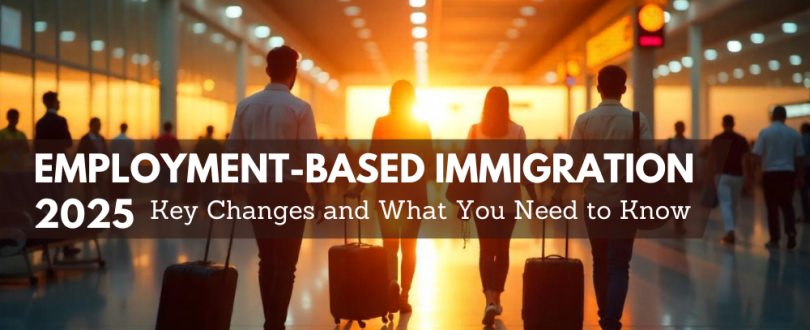
If you’re planning to move to the United States for work—or you’re an employer trying to sponsor foreign talent—you’re likely paying close attention to the employment-based immigration system. In 2025, there have been some important policy updates, changes in visa backlogs, and growing momentum toward modernizing the system.
Whether you’re applying for an H-1B visa, pursuing a green card through employment, or exploring options like the O-1 or L-1, staying updated on what’s changing (and what isn’t) can make a big difference in how you plan your next steps.
This guide breaks down everything you need to know about employment-based immigration in 2025, including:
– The main visa categories
– Processing timelines
– Key changes this year
– Updates on green card backlogs
– What applicants and employers should watch out for
Overview: What Is Employment-Based Immigration?
Employment-based immigration is exactly what it sounds like—immigrating to the U.S. based on job offers, work experience, or professional qualifications. There are two main categories:
1. Temporary Work Visas (Nonimmigrant)
These are visas that allow you to work in the U.S. for a set time period. You must leave when the visa expires unless it’s extended or changed.
Common types include:
H-1B – Specialty occupations requiring a bachelor’s degree
L-1 – Intra-company transfers
O-1 – Individuals with extraordinary ability
TN – Professionals from Canada and Mexico (under USMCA)
E-2 – Treaty investor visas (for entrepreneurs and investors)
2. Permanent Residency (Green Cards)
These allow foreign workers to live and work permanently in the U.S. They’re usually issued through:
EB-1 – Priority workers (extraordinary ability, professors, executives)
EB-2 – Advanced degree professionals or those with exceptional ability
EB-3 – Skilled workers and professionals
EB-4 – Religious workers, special immigrants
EB-5 – Investors creating U.S. jobs

Key Changes in Employment-Based Immigration for 2025
✅ 1. Digital Processing and Modernization
The U.S. Citizenship and Immigration Services (USCIS) has continued to promote online filing and digital case tracking.
– More forms can now be filed electronically, including Form I-140 (Immigrant Petition for Alien Worker).
– Employers and attorneys can access case updates faster via the USCIS portal.
– The PERM labor certification process is slowly moving toward modernization, too, with pilot programs testing digital recruitment submissions.
Why it matters: Expect faster communication, fewer mailing delays, and clearer status updates—assuming you keep your online account active.
✅ 2. H-1B Lottery System Revamp
The H-1B visa lottery system got another tweak in 2025:
– The lottery now prioritizes unique beneficiaries over multiple applications from different employers.
– This was aimed at reducing abuse by companies submitting multiple applications for the same person.
– Registration continues to be in March, with selections announced by April.
Pro tip: If you’re an H-1B hopeful, make sure your prospective employer follows the new rules and understands the registration changes.
✅ 3. Increased Emphasis on STEM and High-Demand Roles
The U.S. is trying to address labor shortages, especially in STEM fields, healthcare, and clean energy. As a result:
– The Department of Labor has added more job titles to the Schedule A list (which bypasses the lengthy PERM process).
– New fast-track options are in the works for workers in AI, cybersecurity, and advanced manufacturing.
If you’re in tech or science, 2025 might be a great time to apply.
✅ 4. Green Card Backlog Management
Long waits for employment-based green cards—especially for workers from India and China—have been a sore spot for years.
In 2025:
– The government has increased visa recapture efforts (reusing unused green cards from prior years).
– There’s ongoing pressure on Congress to pass per-country cap reform (to allow fairer access).
– USCIS has improved its filing guidance, helping eligible applicants move to better categories (like EB-2 to EB-1).
Still, the wait remains long for some applicants, especially under EB-2 and EB-3 from high-demand countries.
✅ 5. PERM Processing Times Are Still Slow (But Improving)
If your green card route requires a PERM labor certification, you’re still in for a wait. But the good news is:
– Processing times have stabilized between 8 to 12 months for most cases.
– Prevailing Wage Determinations (PWDs) are taking 5–8 months, though rural and low-volume job titles see faster results.
Tip for employers: Start the PERM process early—at least 18 months before the employee’s visa maxes out.

Common Visa Pathways in 2025 (Updated Info)
Here’s a snapshot of the most popular work-related visa options and their 2025 updates:
🔹 H-1B Visa
– For: Professionals in specialty occupations
– Cap: 85,000 per year (65K regular + 20K U.S. Master’s degree)
– Validity: 3 years, extendable to 6
– 2025 Update: New lottery rules prevent duplicate entries for the same individual
Challenges:
– Still very competitive
– Requires employer sponsorship
– No self-petition option
🔹 O-1 Visa
– For: Individuals with extraordinary ability in the sciences, arts, education, business, or athletics
– No annual cap
– Can lead to a green card (via EB-1)
– 2025 Update: Expanded recognition for achievements in new sectors like AI, biotech, and design
Good option for: Entrepreneurs, researchers, creatives
🔹 L-1 Visa
– For: Intra-company transferees (execs, managers, specialized knowledge staff)
– Validity: Up to 7 years (L-1A), 5 years (L-1B)
– 2025 Update: Stricter documentation required for specialized knowledge claims
Perk: Can lead to a green card under EB-1C without PERM
🔹 EB-2 and EB-3 Green Cards
– For: Professionals with advanced degrees (EB-2) or bachelor’s degrees/skilled workers (EB-3)
– Requires PERM unless you qualify for NIW (National Interest Waiver)
– Backlogs continue for India and China in 2025
– Visa Bulletin remains a critical tracking tool
🔹 EB-1 Green Card
– For: People with extraordinary ability, outstanding researchers, or executives
– No PERM required
– Faster processing, especially for non-backlogged countries
– Self-petition allowed for EB-1A
Tip: If you qualify for EB-1, it’s usually the fastest way to a green card.
Top Tips for Applicants in 2025
1. Create a USCIS Online Account
More updates and forms are digital. Track your status and respond to RFEs faster.
2. Start the Process Early
If you’re on a temporary visa (like H-1B or L-1), don’t wait until the last minute. The green card process can take years depending on your category.
3. Use the Visa Bulletin
Published monthly, this tells you whether your priority date is current. It’s essential for tracking your wait time.
4. Keep an Eye on PERM Timelines
These change often. Check current timelines on the DOL’s FLAG system.
5. Don’t Ignore the National Interest Waiver (NIW)
If you’re in a field that benefits the U.S. economy or public health, you might bypass PERM altogether.
What Employers Should Know in 2025
– Compliance is key. USCIS and DOL have ramped up employer audits—make sure your documentation and wage compliance are airtight.
– Plan for long timelines. Between PERM, I-140, and visa interviews, the process can stretch over 2–3 years. Start early.
– Retain legal help. An experienced immigration attorney can prevent delays and keep your petitions moving.
– Use premium processing wisely. It’s expensive, but if you’re on a tight hiring timeline, it might be worth it.
Final Thoughts
Employment-based immigration in 2025 is a mix of slow-moving reforms, digital improvements, and ongoing backlogs. If you’re applying as a worker or hiring as an employer, being proactive and informed is more important than ever.
Key takeaways:
– Start early
– Watch the Visa Bulletin
– Use digital tools
– Stay compliant
– Ask for help when needed
The U.S. remains a top destination for talent. The system may be complex, but with the right planning and support, your goals are still within reach.
Have questions about your employment-based visa options in 2025? Drop them below or reach out for more guidance.

